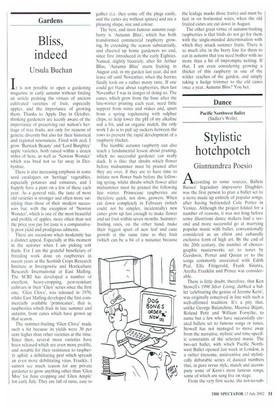Bliss, indeed
Ursula Buchan
It is not possible to open a gardening magazine in early autumn without finding an article praising the virtues of ancient cultivated varieties of fruit, especially apples, and the importance of growing them. Thanks to Apple Day in October, thinking gardeners are keenly aware of the importance of preserving our nation's heritage of tree fruits, not only for reasons of genetic diversity but also for their historical and regional resonances. Fired with zeal. I grow 'Barnack Beauty' and 'Lord Burghley' apple varieties, both raised within a dozen miles of here, as well as 'Newton Wonder' which was bred not so far away in Derbyshire.
There is also increasing emphasis in some seed catalogues on 'heritage' vegetables, especially potatoes and tomatoes, and I happily have a punt on a few of these each year. As a general rule, the taste of most old varieties is stronger and often more satisfying than those of their modern successors but, with the exception of 'Newton Wonder', which is one of the most beautiful and prolific of apples, more often than not the price you pay for taste is a comparatively poor yield and prodigious ailments.
There are occasions when modernity has a distinct appeal. Especially at this moment in the summer when I am picking soft fruits. For I am the grateful beneficiary of breeding work done on raspberries in recent years at the Scottish Crops Research Institute at Invergowrie and Horticulture Research International at East Mailing. The SCRI has developed a number of excellent, heavy-cropping, pest-resistant cultivars in their 'Glen' series since the first one. 'Glen Clova', was released in 1970, whilst East Mailing developed the first commercially available `primocanes', that is, raspberries which fruit in late summer and autumn, from canes which have grown up that season.
The summer-fruiting 'Glen Clova' made such a hit because its yields were 30 per cent higher than other varieties at the time. Since then, several more varieties have been released which are even more prolific, and notable for their resistance to raspberry aphid, a debilitating pest which spreads an even more debilitating virus. Frankly. I cannot see much reason for any private gardener to grow anything other than 'Glen Moy' for June cropping and 'Glen Ample' for early July. They are full of taste, easy to
gather (i.e. they come off the plugs easily, and the canes are without spines) and are a pleasing shape, size and colour.
The best, and most famous autumn raspberry is 'Autumn Bliss', which has both transformed commercial raspberry growing, by extending the season substantially, and cheered up home gardeners no end, since first introduced in the early Eighties. Named, slightly bizarrely. after Sir Arthur Bliss, 'Autumn Bliss' starts fruiting in August and, in my garden last year, did not leave off until November, when the berries finally took on a rather musty taste. If one could get blasé about raspberries, then last November I was in danger of doing so. The canes, which grow from the base after the late-winter pruning each year, need little support from wires and stakes and, apart from a spring topdressing with sulphur chips, to help lower the p1-1 of my alkaline soil a bit, and an organic mulch, the only work I do is to pull up suckers between the rows to prevent the rapid development of a raspberry thicket.
The humble autumn raspberry can also teach a fundamental lesson about pruning, which no successful gardener can really duck. It is this: that shrubs which flower before midsummer must be pruned after they are over, if they are to have time to initiate new flower buds before the following spring, whilst shrubs which flower after midsummer must be pruned the following late winter. Primocane raspberries are therefore quick, not slow, growers. When cut down completely in February (which could not be simpler, incidentally) new canes grow up fast enough to make flower and set fruit within seven months. Summerfruiting ones, on the other hand, make their biggest spurt of new leaf and cane growth at the same time as they fruit (which can be a bit of a nuisance because the leafage masks those fruits) and must be tied in on horizontal wires, when the old fruited canes are cut down in August.
The other great virtue of autumn-fruiting raspberries is that birds do not go for them with the single-minded determination with which they attack summer fruits. There is so much else in the berry line for them to eat in autumn that you need bother with no more than a bit of impromptu netting. If that. I am even considering growing a thicket of this raspberry in one of the wilder reaches of the garden, and simply taking a hedge trimmer to the old canes once a year. Autumn Bliss? You bet.


































































 Previous page
Previous page